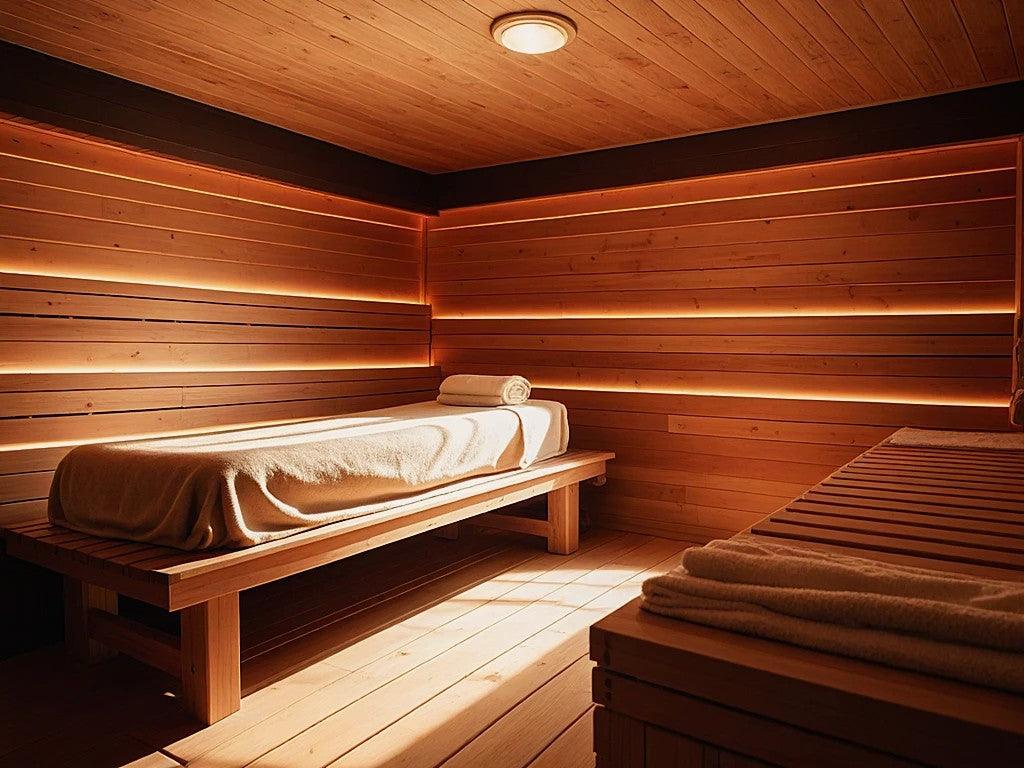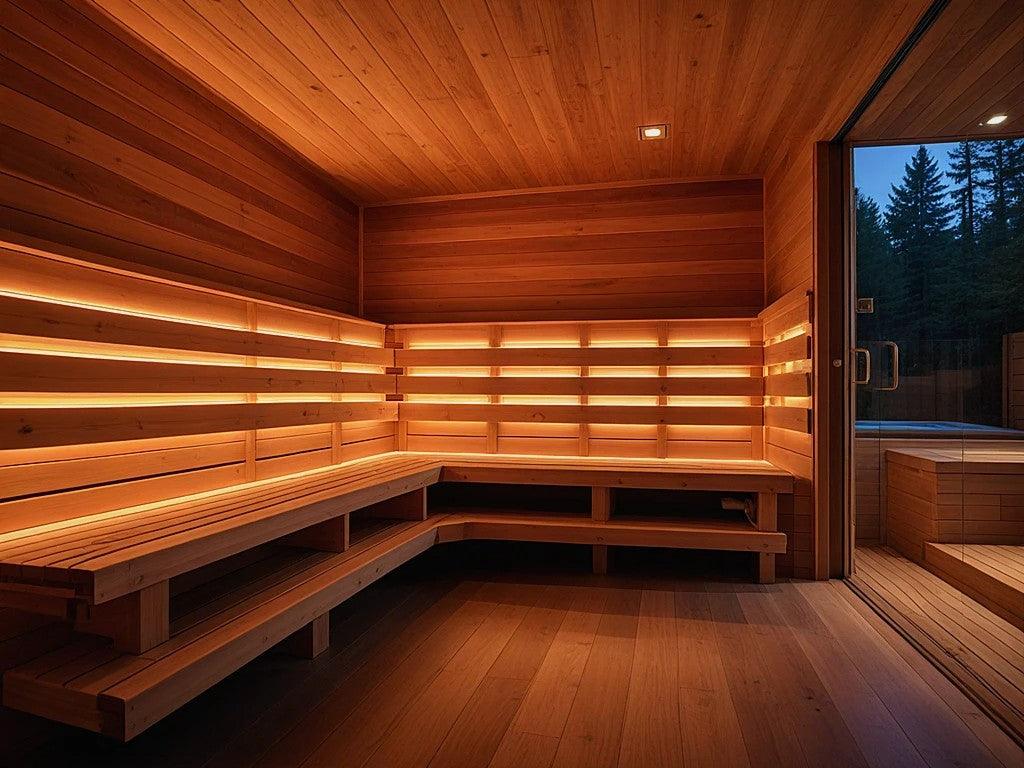Sauna Before or After Massage: What's Best for Your Body?
If you're trying to maximize your wellness routine, you've probably wondered whether you should hit the sauna before or after getting a massage. It's a question that comes up more often than you'd think—and for good reason. The order in which you combine these therapies can significantly impact how your body responds, recovers, and relaxes.
Both saunas and massages offer incredible benefits on their own. Saunas promote circulation, help flush out toxins through sweating, and provide deep muscle relaxation through heat exposure. Massages improve blood flow, release muscle tension, and support lymphatic drainage. But when you combine them strategically? That's when the real magic happens.
In this guide, we'll break down the science-backed benefits of using a sauna before versus after a massage, help you determine which approach works best for your goals, and share best practices for combining these powerful wellness therapies.

Understanding the Science Behind Heat and Massage Therapy
Before we dive into timing, it's helpful to understand what's actually happening in your body during each therapy.
What Happens in a Sauna
When you sit in a sauna—whether it's a traditional Finnish-style sauna or an infrared model—your body experiences several physiological changes. Your heart rate increases (mimicking moderate exercise), blood vessels dilate to improve circulation, and your core temperature rises, triggering perspiration. Research published in the European Journal of Preventive Cardiology found that regular sauna bathing is associated with reduced cardiovascular risk and improved autonomic function.
The heat penetrates your muscles, making them more pliable and relaxed. Your body also releases endorphins, those feel-good chemicals that promote relaxation and stress relief. Studies show that passive heat therapy can lower cortisol levels—your body's primary stress hormone—helping you achieve a calmer state of mind.
What Happens During a Massage
Massage therapy works through mechanical pressure and manipulation of soft tissues. A skilled massage therapist can increase peripheral blood flow and oxygenation, particularly in areas experiencing tension or soreness. According to research in the Journal of Alternative and Complementary Medicine, therapeutic massage significantly enhances circulation and promotes faster recovery from physical stress.
Massage also stimulates your lymphatic system, which is responsible for removing waste products and toxins from your tissues. Unlike your cardiovascular system, the lymphatic system doesn't have a pump (like the heart), so it relies on muscle contractions and external pressure to move fluid through the body. This is why massage is so effective at reducing swelling and promoting detoxification.

Curious about how saunas can benefit your wellness routine? Check out our range of hybrid saunas for a multi-faceted approach to relaxation.
Sauna Before Massage: Preparing Your Body for Deep Work
Using a sauna before your massage session can set the stage for more effective bodywork. Here's why this approach works so well for many people.
Loosens Tight Muscles for Better Manipulation
Heat is one of nature's most effective muscle relaxants. When you spend 10-15 minutes in a sauna before your massage, the elevated temperature increases blood flow to your muscles and connective tissues. This makes your muscles more pliable and easier for your massage therapist to work with.
Think of it like warming up clay before sculpting—you get better results when the material is more malleable. If you're dealing with chronic tightness, knots, or post-workout soreness, warming up in the sauna first allows your therapist to work deeper into problem areas without causing discomfort.
Kickstarts the Detoxification Process
One of the primary benefits of sauna use is its ability to induce sweating, which helps your body eliminate various compounds. While the kidneys and liver remain your body's primary detoxification organs, research shows that certain substances—including some heavy metals and chemical compounds—can be excreted through sweat.
Starting with a sauna opens your pores and gets the elimination process going. When you follow up with a massage that stimulates lymphatic drainage, you're essentially creating a one-two punch for helping your body remove metabolic waste products more efficiently.
Reduces Pre-Massage Anxiety and Tension
If you tend to feel anxious or have trouble relaxing during massages, starting with a sauna session can help. The heat exposure has been shown to calm the nervous system by activating your parasympathetic response—essentially switching your body from "fight or flight" mode to "rest and digest" mode.
Research in Frontiers in Psychology demonstrates that passive heat therapy lowers cortisol and perceived stress levels in adults. By the time you transition to the massage table, your nervous system is already in a more receptive state, allowing you to get more benefit from the bodywork.
Best For
- People with significant muscle tension or stiffness
- Athletes preparing for deep tissue or sports massage
- Anyone who has trouble relaxing during massage sessions
- Those dealing with chronic pain or limited range of motion
Considering adding a sauna to your home wellness routine? Explore our selection of infrared saunas that deliver gentle, penetrating heat ideal for pre-massage muscle preparation.
Sauna After Massage: Extending and Enhancing Recovery
On the flip side, using the sauna after your massage offers a different set of advantages that many people find even more beneficial.
Prolongs Muscle Relaxation and Recovery
After a massage, your muscles are already in a deeply relaxed state. The increased circulation from the bodywork has delivered fresh oxygen and nutrients to your tissues while helping remove metabolic waste products. Stepping into a sauna afterward helps maintain this improved blood flow, essentially extending the benefits of your massage.
A study published in the Journal of Strength and Conditioning Research found that post-exercise sauna bathing enhanced muscle recovery and decreased muscle soreness in athletes. The same principle applies after massage—the continued heat exposure supports tissue repair and helps prevent the stiffness that can sometimes occur as your muscles cool down.
Completes the Detoxification Cycle
If your massage therapist focused on lymphatic drainage or worked to release deep tissue tension, your lymphatic system is already mobilizing waste products and toxins. Following up with a sauna session allows you to sweat out these substances, completing the detoxification cycle that your massage initiated.
Research in Clinical Physiology and Functional Imaging showed that both heat exposure and mechanical pressure (like massage) increase lymphatic output and waste removal efficiency. Using them in sequence creates a complementary effect.
Deepens Relaxation for Better Sleep and Stress Relief
The post-massage glow you feel—that sense of deep calm and contentment—can be intensified by ending your session in the sauna. The additional heat exposure helps maintain elevated endorphin levels and keeps your nervous system in that relaxed, parasympathetic state.
Many people find that using the sauna after a massage leads to better sleep that night. The gradual cooling of your body temperature after leaving the sauna (and post-massage) actually promotes deeper sleep, as your body associates dropping core temperature with sleep onset.
Best For
- Athletes and active individuals focused on recovery
- People seeking maximum relaxation and stress relief
- Anyone who wants to extend the benefits of their massage
- Those prioritizing sleep quality improvement
For versatile options that work perfectly for post-massage recovery, check out our hybrid saunas that combine traditional and infrared heating elements.
Why Not Both? The Case for Bookending Your Massage
Here's where things get interesting: some wellness enthusiasts swear by using the sauna both before AND after massage, essentially bookending the bodywork with heat therapy.
This approach combines the muscle-preparation benefits of pre-massage sauna use with the recovery-enhancing effects of post-massage heat. If you have the time and your facility offers both options, you might experiment with:
- 10-15 minutes of sauna before massage to warm and loosen muscles
- 30-60 minutes of massage therapy
- 10-20 minutes of sauna after massage to extend relaxation and recovery
Just be mindful of total heat exposure time and ensure you're staying well-hydrated throughout the process (more on that below).
Infrared vs. Traditional Sauna: Does It Matter?
The type of sauna you use can influence your experience, though both traditional and infrared saunas offer benefits for pairing with massage.
Traditional Saunas operate at higher temperatures (typically 150-195°F) and heat the air around you. They provide a more intense cardiovascular response and are excellent for those who enjoy the feeling of extreme heat. The higher temperatures can be particularly effective for pre-massage muscle preparation.
Infrared Saunas use lower ambient temperatures (usually 120-150°F) but penetrate deeper into tissues at a cellular level. According to research in Complementary Therapies in Medicine, infrared saunas improved sleep quality and muscle relaxation due to their gentler approach and deeper tissue penetration. Many people find infrared saunas more comfortable for longer post-massage sessions.
For pairing with massage, infrared saunas are often preferred because the lower temperature is less likely to cause lightheadedness or dehydration, especially after bodywork when you're already in a deeply relaxed state.
Best Practices for Combining Sauna and Massage
No matter which sequence you choose, following these guidelines will help you maximize benefits and avoid potential issues.
Timing and Duration
- Pre-massage sauna: 10-15 minutes is typically sufficient to warm muscles without overdoing it
- Post-massage sauna: 10-20 minutes allows for continued relaxation without excessive heat exposure
- Between sessions: If using sauna before massage, allow 5-10 minutes for your body temperature to normalize before bodywork begins
Hydration Is Non-Negotiable
This cannot be stressed enough: proper hydration is essential when combining sauna and massage. Both therapies promote fluid loss—saunas through sweating, massage through lymphatic drainage and increased circulation.
Drink at least 16-20 ounces of water before your session, sip water during if possible, and consume another 20-24 ounces afterward. Dehydration can not only diminish the benefits of both therapies but can also impair kidney function and lead to headaches or dizziness.
Listen to Your Body
Everyone responds differently to heat therapy. Some people thrive on high temperatures and extended sessions, while others feel best with shorter, gentler exposure. Pay attention to how you feel:
- If you feel dizzy, nauseous, or excessively uncomfortable, exit the sauna immediately
- Don't push through discomfort to hit a certain time goal
- If you have cardiovascular issues, are pregnant, or have certain medical conditions, consult your physician before combining sauna and massage
Consider Your Goals
Your wellness objectives should guide your approach:
- For athletic recovery: Sauna after massage helps extend the therapeutic effects
- For chronic pain or stiffness: Sauna before massage prepares tissues for deeper work
- For maximum relaxation: Either approach works, though post-massage sauna may promote better sleep
- For detoxification: Bookending (before and after) may provide the most comprehensive approach
Start Conservatively
If you're new to either therapy, don't jump straight into extended combined sessions. Start with shorter durations and gradually increase as your body adapts. There's no award for toughing out an uncomfortably long sauna session.
Ready to create the ultimate at-home wellness sanctuary? Browse our complete collection of traditional saunas designed for reliable performance and lasting benefits.
Safety Considerations and Contraindications
While combining sauna and massage is generally safe for most people, certain conditions warrant caution or medical consultation:
Avoid combining these therapies if you have:
- Acute inflammation or infections (cellulitis, fever)
- Uncontrolled high blood pressure or heart disease
- Recent injuries or surgery (without medical clearance)
- Pregnancy (consult your healthcare provider)
- Certain skin conditions that may be aggravated by heat or massage
Use caution if you:
- Are taking medications that affect circulation or blood pressure
- Have diabetes (heat can affect blood sugar levels)
- Experience frequent dizziness or fainting
- Have very sensitive skin
When in doubt, discuss your wellness plans with your healthcare provider, especially if you have any chronic health conditions.
Frequently Asked Questions
Should I shower between sauna and massage sessions?
If you're doing sauna before massage, a quick cool-down shower is often recommended—it brings your body temperature down slightly and makes the experience more comfortable for your massage therapist. If you're doing sauna after massage, showering is optional and based on personal preference, though many people prefer to wait until after the final sauna session to preserve the oils and lotions used during massage.
How long should I wait after eating before combining sauna and massage?
Wait at least 1-2 hours after a large meal. Digestion diverts blood flow to your digestive system, and adding sauna heat or massage can feel uncomfortable on a full stomach. A light snack 30-60 minutes beforehand is usually fine.
Can I use a sauna after a deep tissue massage?
Yes, but start with lower temperatures and shorter durations. Deep tissue massage can sometimes cause temporary soreness (similar to post-workout soreness), and excessive heat immediately afterward might be uncomfortable for some people. Listen to your body and adjust accordingly.
Is infrared or traditional sauna better before a massage?
Both work well, but infrared saunas may be slightly better for pre-massage sessions due to their lower ambient temperature and deeper tissue penetration. They warm muscles effectively without causing as much overall body heat stress, which can be beneficial before lying down for bodywork.
How often can I safely combine sauna and massage?
For general wellness, once or twice a week is reasonable for most people. Athletes in heavy training might combine them more frequently, while others may prefer less frequent sessions. Your frequency should depend on your overall health, fitness level, hydration status, and how your body responds.
Does sauna help with the soreness that sometimes comes after massage?
Yes, post-massage sauna can help reduce delayed-onset soreness by maintaining circulation and promoting faster recovery. The continued heat keeps blood flowing to tissues being repaired, which can minimize the temporary discomfort some people experience after deep bodywork.
Can I do self-massage techniques in the sauna?
Light self-massage techniques like gentle stretching or foam rolling can complement your sauna session, but save intensive bodywork for outside the sauna where you can maintain proper hydration and won't risk overheating.
What temperature should the sauna be for optimal benefits with massage?
Traditional saunas are typically set between 150-180°F, while infrared saunas operate between 120-140°F. For pairing with massage, staying on the lower end of these ranges often provides the best experience without excessive heat stress.
The Bottom Line: Personalizing Your Approach
So, should you use the sauna before or after massage? The honest answer is: it depends on your goals, preferences, and how your body responds.
Choose sauna BEFORE massage if you:
- Have significant muscle tension or stiffness
- Want to prepare your body for deep tissue work
- Need help relaxing before bodywork begins
- Are dealing with chronic pain or restricted range of motion
Choose sauna AFTER massage if you:
- Want to extend the relaxation and recovery effects
- Are focused on athletic recovery and performance
- Prefer a gentler, more gradual relaxation experience
- Want to maximize sleep quality that night
Try bookending (both before and after) if you:
- Have ample time for an extended wellness session
- Want the most comprehensive approach to recovery
- Are preparing for or recovering from intense physical activity
- Simply enjoy both experiences and want to maximize benefits
Whichever approach you choose, the combination of sauna and massage represents one of the most effective natural wellness strategies available. Both therapies have stood the test of time across cultures worldwide, and modern research continues to validate their numerous benefits.
The key is experimenting with different approaches, staying properly hydrated, listening to your body's feedback, and adjusting your routine based on what leaves you feeling your absolute best. Your ideal protocol might even change based on your stress levels, activity intensity, or wellness goals at any given time.
Start with the basics—proper hydration, conservative session lengths, and attention to how you feel—and you'll be well on your way to creating a personalized sauna and massage routine that supports your health and recovery for years to come.
External Resource: For more information on the cardiovascular and wellness benefits of regular sauna use, visit the Mayo Clinic's comprehensive guide to sauna health benefits.









Leave a comment
This site is protected by hCaptcha and the hCaptcha Privacy Policy and Terms of Service apply.